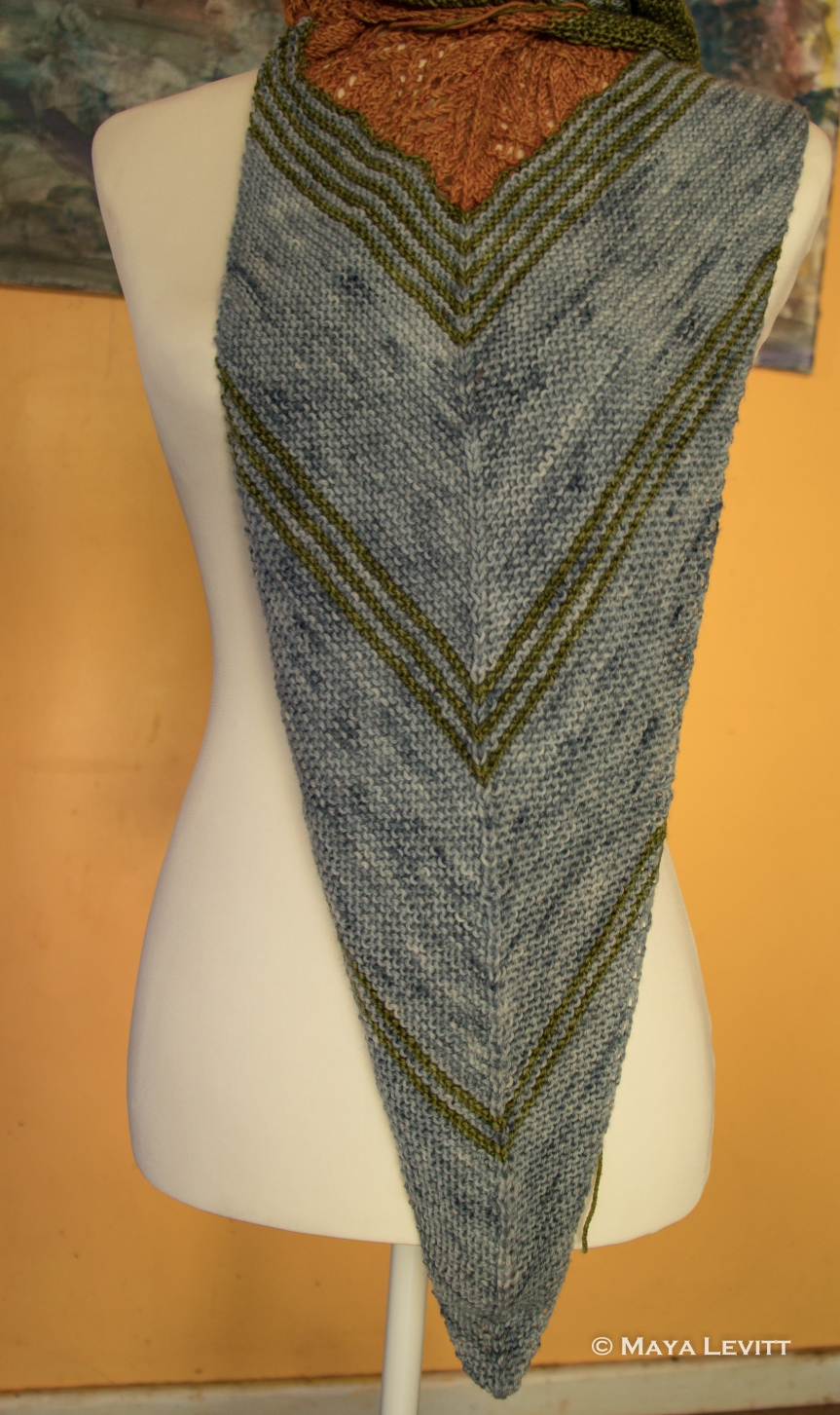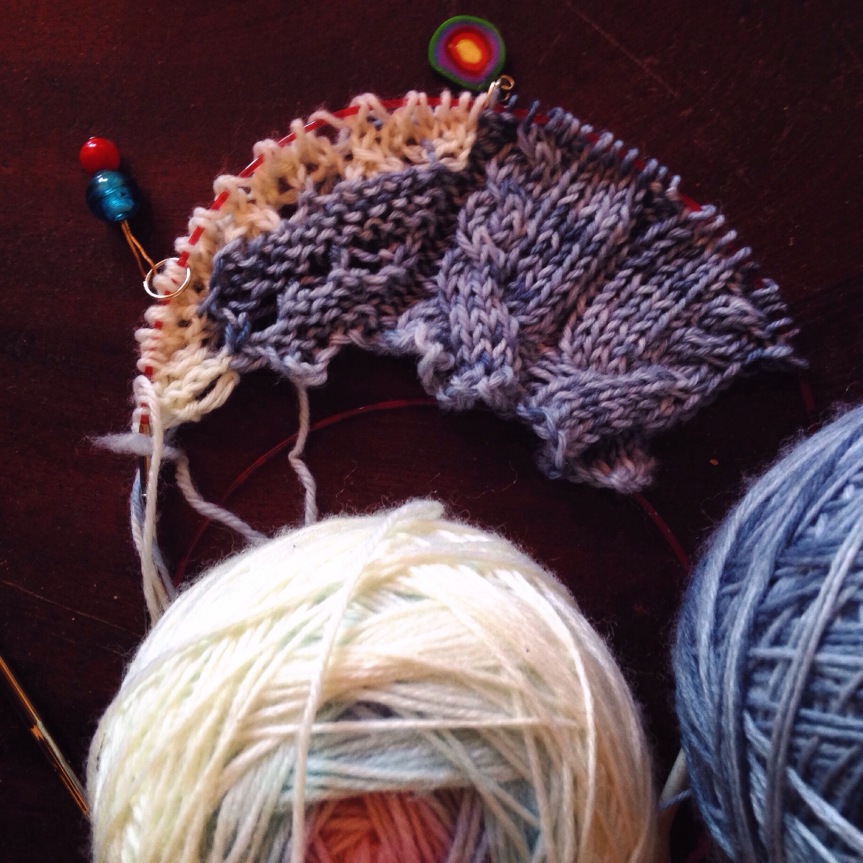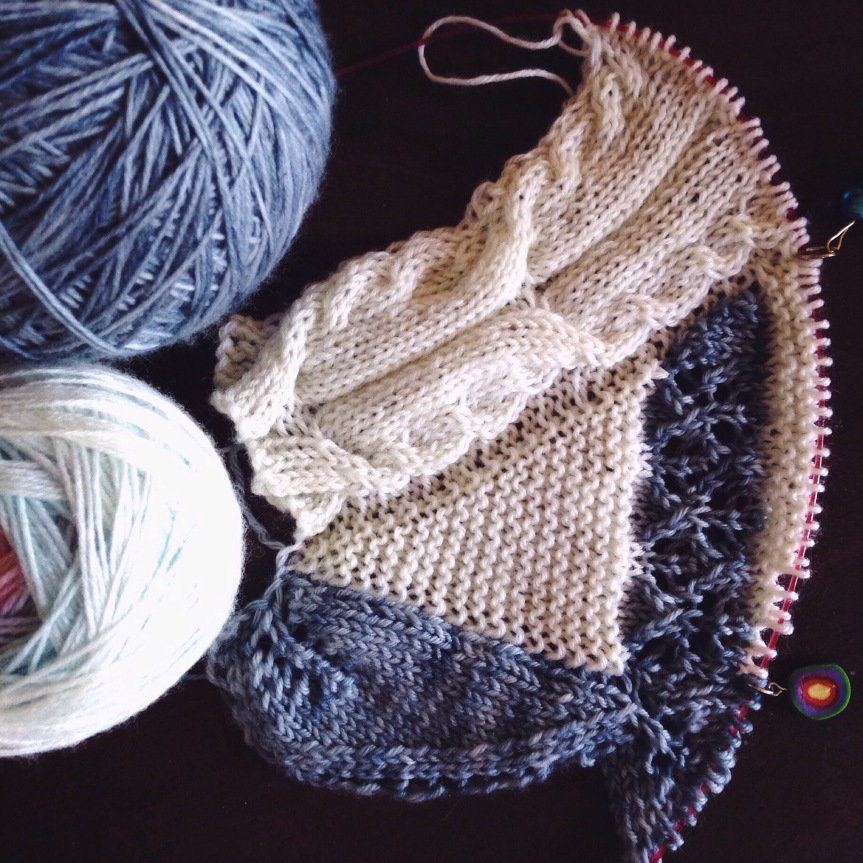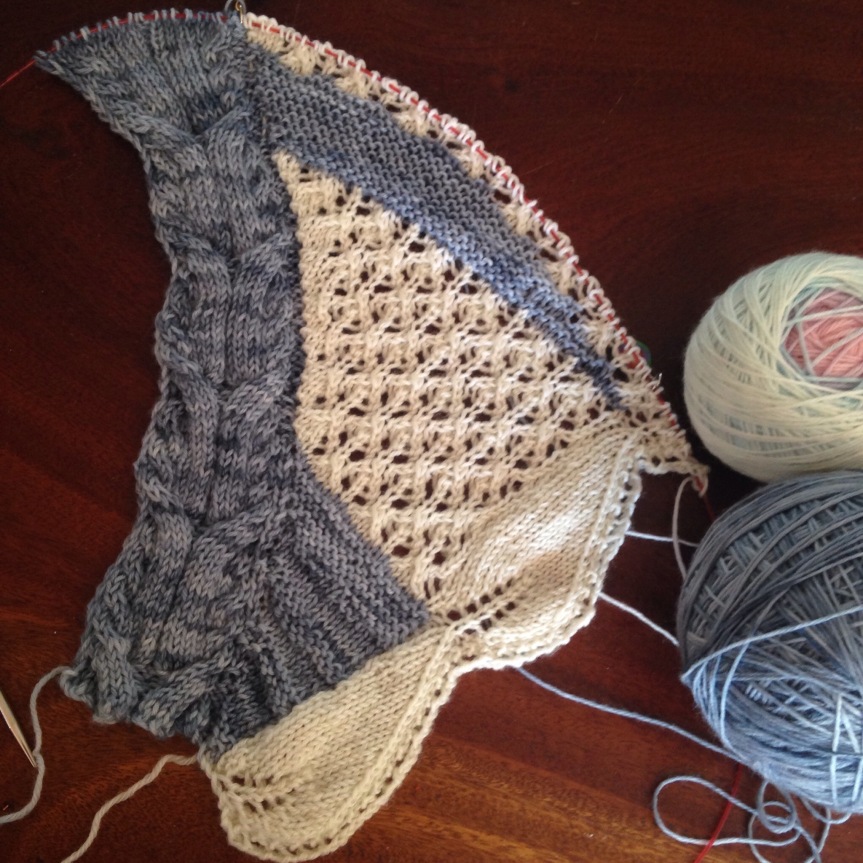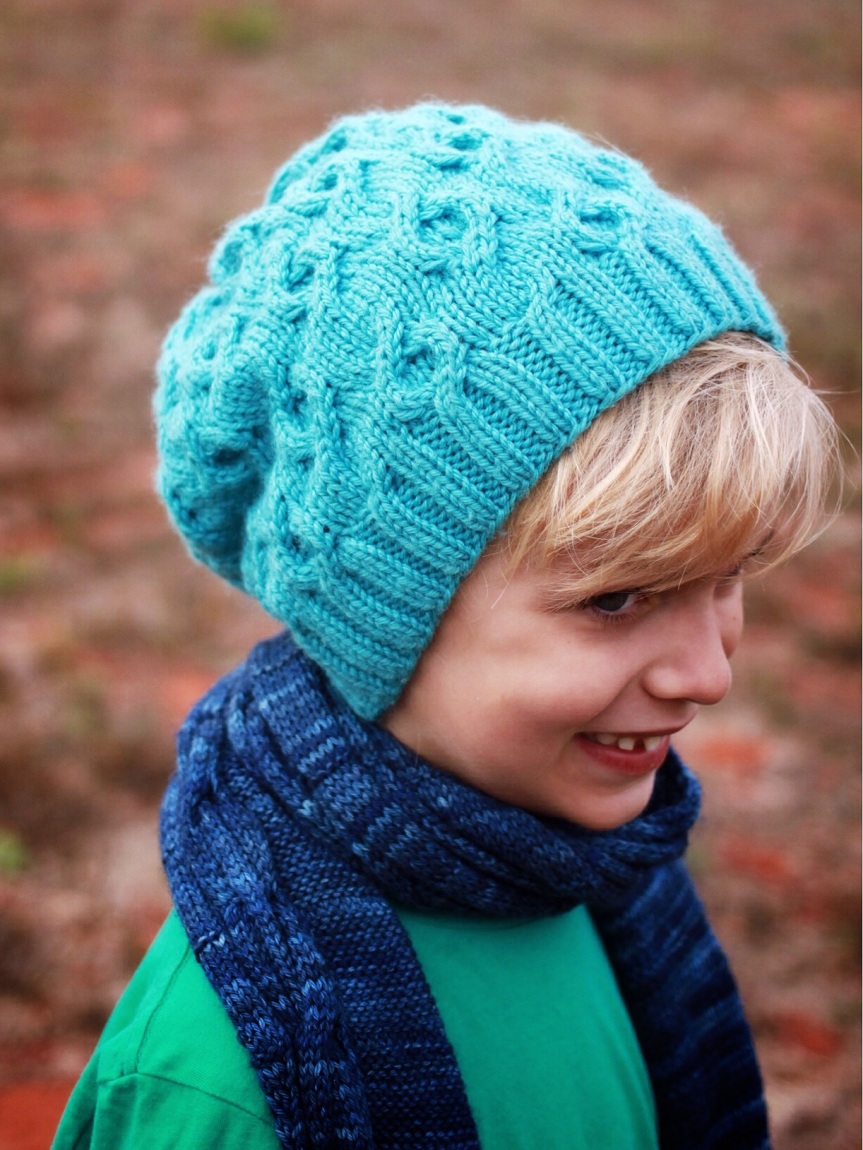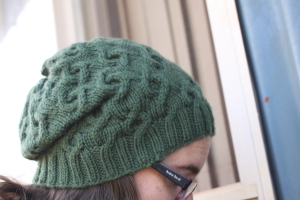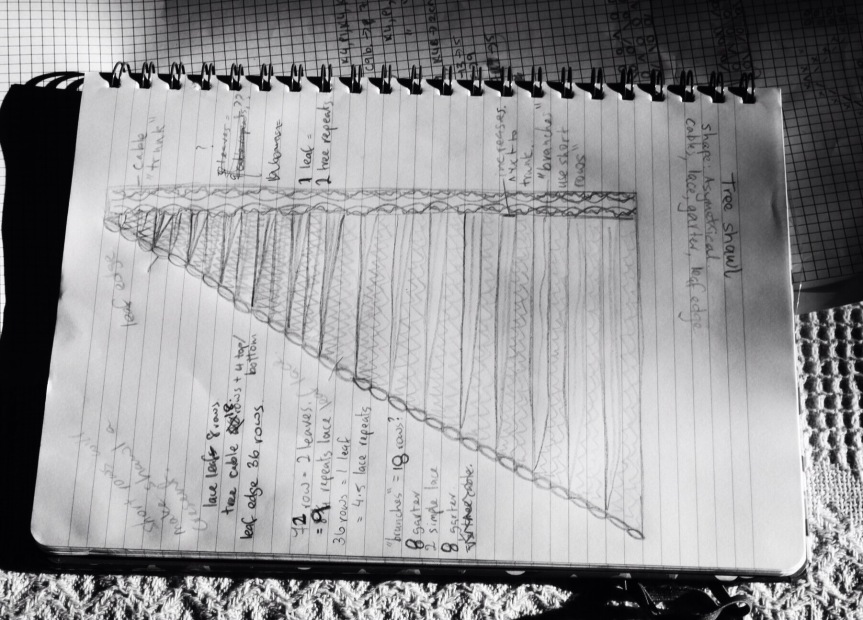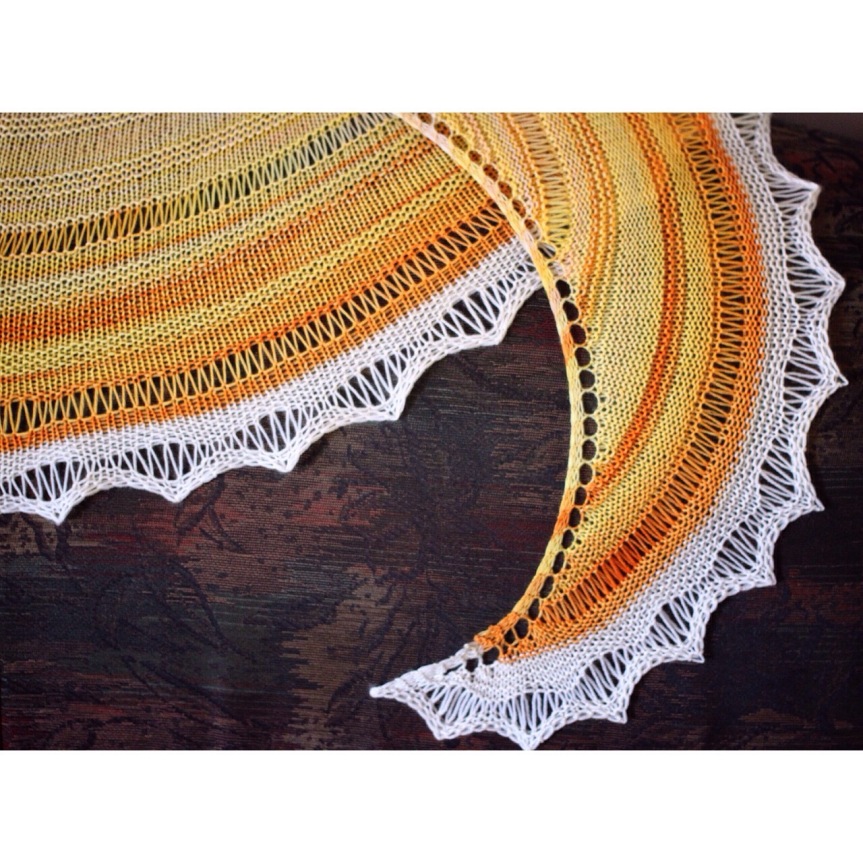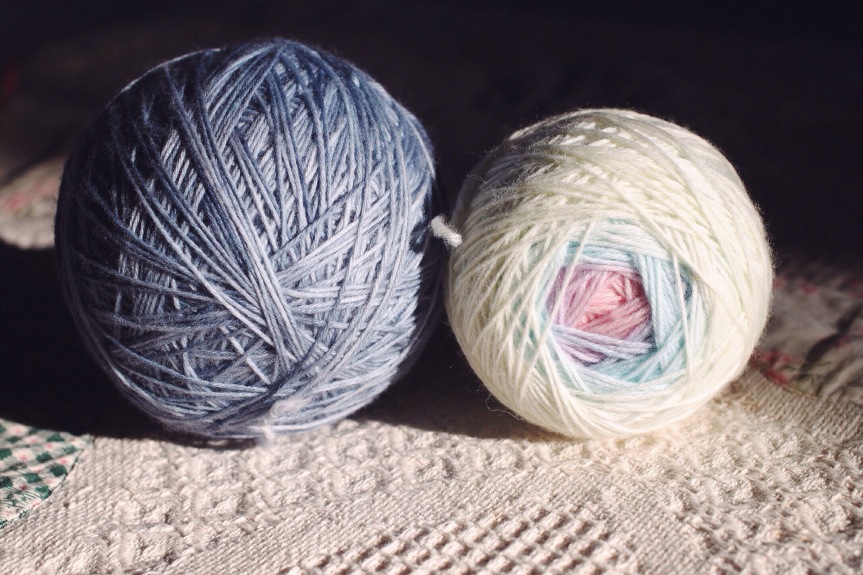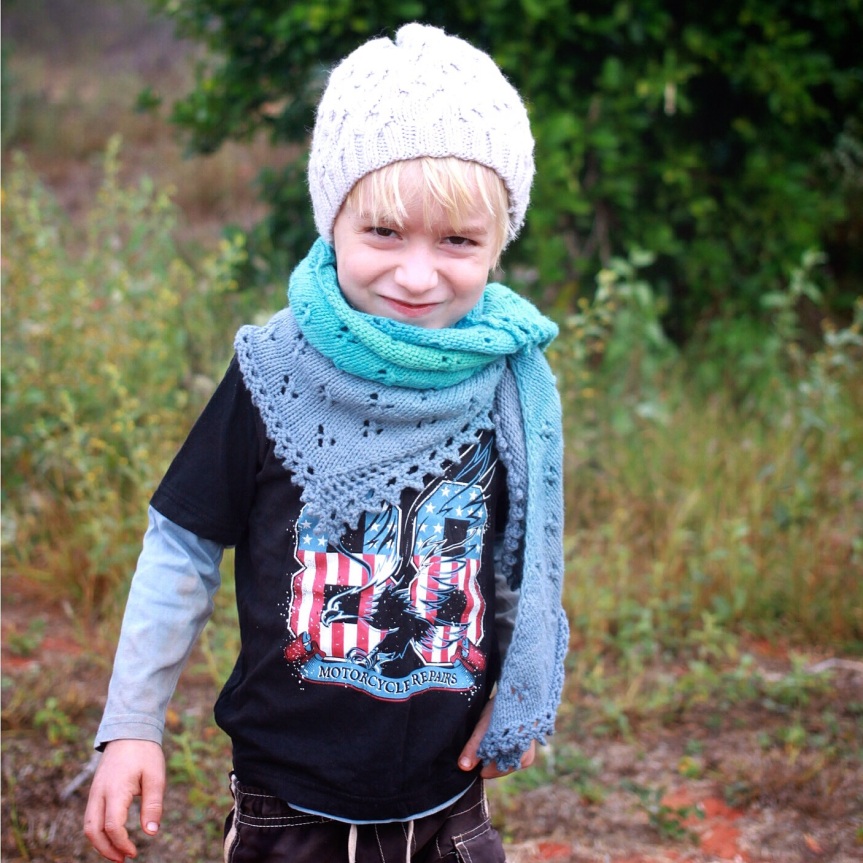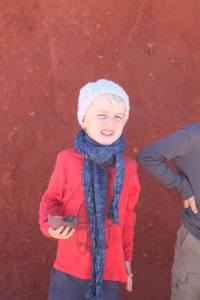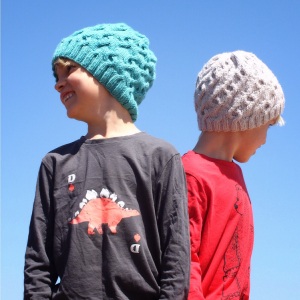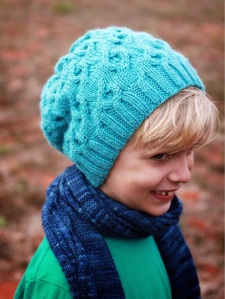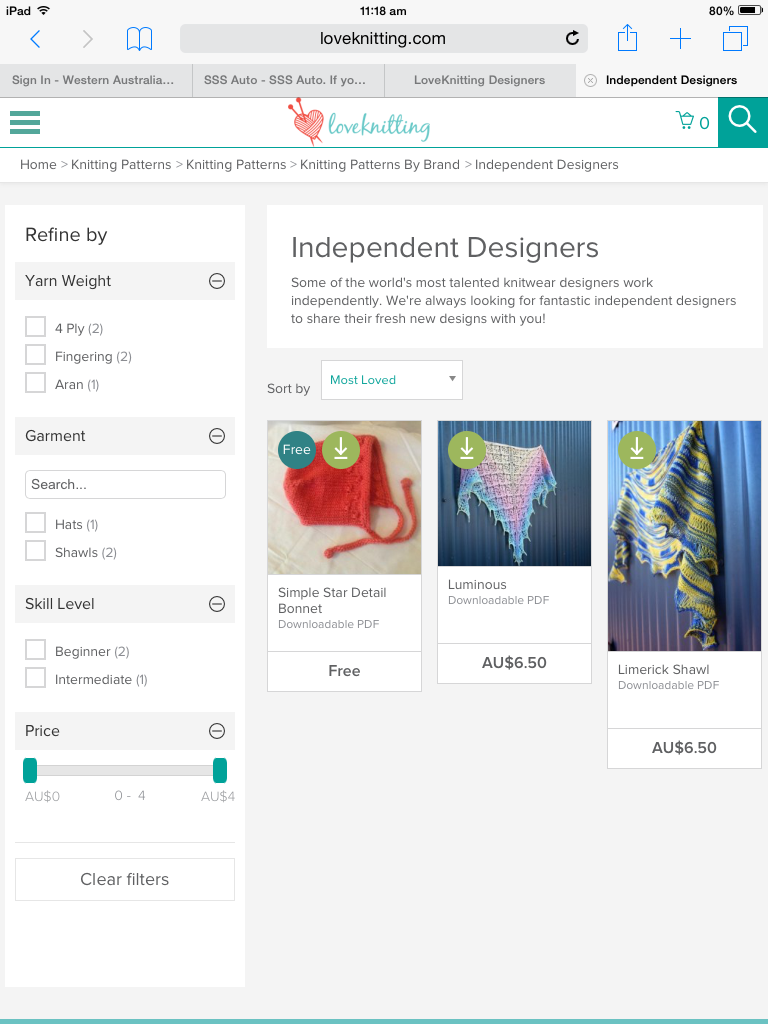It’s late, very very late. The last two weeks has involved lots of technological issues, including a computer whose graphics card is just not a happy chap, a modem that I suspect is on it’s last legs, a head ache inducing charting program that somehow was insisting I had 1200 stitches in one row, and the usual stuff in the build up to Christmas. But here is the last section of the shawl.
Here is the key. Written instructions are below.
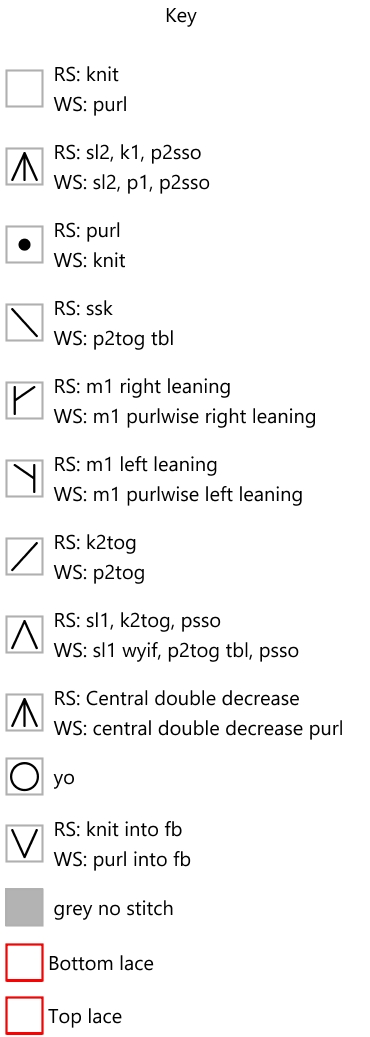
Section 4: Lace
Change to colour C
Chart B
Row 1 (RS): Kfb, k2, m1l, k, k2tog, yo, k2tog, [p, ssk, yo, ssk, k, m1r, k, m1l, k, k2tog, yo, k2tog] x12, p, k, cdd, k, p, ssk, yo, ssk, k, m1r, k, [m1l, k, k2tog, yo, k2tog, p, ssk, yo, ssk, k, m1r, k] x 2, k2, kfb, k. (193 sts)
Row 2 (WS and all WS rows): k2, purl all purl stitches, knit all knit stitches until 2 stitches before end of row, kfab, k.
Row 3: Kfb, ssk, k, m1r, k, m1l, k, k2tog, yo, k2tog, [p, ssk, yo, ssk, k, m1r, k, m1l, k, k2tog, yo, k2tog] x 12, p, cdd, p, ssk, yo, ssk, k, m1r, k, [m1l, k, k2tog, yo, k2tog, p, ssk, yo, ssk, k, m1r, k] x2, k3, kfb, k. (194 sts)
Row 5: Kfb, ssk, yo, ssk, k, m1r, k, m1l, k, k2tog, yo, k2tog, [p, ssk, yo, ssk, k, m1r, k, m1l, k, k2tog, yo, k2tog] x 12, cdd, ssk, yo, ssk, k, m1r, k, [m1l, k, k2tog, yo, k2tog, p, ssk, yo, ssk, k, m1r, k] x2, m1l, k, k2tog, k, kfb, k. (195 sts)
Row 7: Kfb, k2, (yo, ssk) x 2, k2, [k, (k2tog, yo) x 2, k, (yo, ssk) x 2, k2] x 12, k, yo, ssk, k2, [k, (k2tog, yo) x 2, k, (yo, ssk) x 2, k2] x 2, k, k2tog, yo, k2, kfb, k. (196 sts)
Row 9: Kfb, k2tog, yo, k3, (yo, ssk) x 2, k, [(k2tog, yo) x 2, k3, (yo, ssk) x 2, k] x 12, k2tog, yo, k, cdd, k, yo, ssk, k, [(k2tog, yo) x 2, k3, (yo, ssk) x 2, k] x2, (k2tog, yo) x 2, k2, kfb, k. (197 sts)
Row 11: Kfb, k, (k2tog, yo) x 2, k, (yo, ssk) x 2, yo, sl1, k2tog, psso, [(yo, k2tog) x 2, yo, k, (yo, ssk) x 2, yo, sl1, k2tog, psso] x 12, yo, k, cdd, k, yo, sl1, k2tog, psso, [(yo, k2tog) x 2, yo, k, (yo, ssk) x 2, yo, sl1, k2tog, psso] x 2, (yo, k2tog) x 2, yo, k2, kfb, k. (198 sts)
Row 13: Kfb, k2, (k2tog, yo) x 2, k3, (yo, ssk) x 2, k, [(k2tog, yo) x 2, k3, (yo, ssk) x 2, k] x 12, k, cdd, k2, (k2tog, yo) x 2, k2, [k, (yo, ssk) x 2, k, (k2tog, yo) x 2, k2] x 2, k2, kfb, k. (199 sts)
Row 15: Kfb, yo, ssk, yo, sl1, k2tog, psso, yo, k2tog, yo, k2, [k3, yo, ssk, yo, sl1, k2tog, psso, yo, k2tog, yo, k2] x 12, k3, (yo, ssk) x 2, cdd, (k2tog, yo) x 2, k3, [k2, yo, ssk, yo, sl1, k2tog, psso, yo, k2tog, yo, k3] x 2, k3, kfb, k. (200 sts)
Row 17: Kfb, k3, yo, ssk, k, k2tog, yo, k2tog, k, m1r, [k, m1l, k, ssk, yo, ssk, p, k2tog, yo, k2tog, k, m1r] x 12, k, m1l, k, ssk, yo, ssk, cdd, k2, k2tog, k, m1r, k, [m1l, k, ssk, yo, ssk, p, ssk, yo, k2tog, k, m1r, k] x 2, m1l, k3, kfb, k. (201 sts)
Row 19: Kfb, m1r, [k, m1l, k, k2tog, yo, k2tog, p, ssk, yo, ssk, k, m1r] x 13, k, m1l, k, k2tog, k, cdd, k, ssk, k, m1r, k, [m1l, k, k2tog, yo, k2tog, p, ssk, yo, ssk, k, m1r, k] x 2, m1l, k, k2tog, yo, k2tog, kfb, k. (202 sts)
Row 21: Kfb, k2, m1r, [k, m1l, k, k2tog, yo, k2tog, p, ssk, yo, ssk, k, m1r] x 13, k4, cdd, ssk, k, m1r, k, [m1l, k, k2tog, yo, k2tog, p, ssk, yo, ssk, k, m1r, k] x 2, m1l, k, k2tog, yo, k2tog, p, kfb, k. (203 sts)
Row 23: Kfb, k, ssk, yo, ssk, k, [k2, (k2tog, yo) x 2, k, (yo, ssk) x 2, k] x 13, k3, cdd, k3, [k, (k2tog, yo) x 2, k, (yo, ssk) x 2, k2] x 2, k, (k2tog, yo) x 2, k2, kfb, k. (204 sts)
Row 25: Kfb, k2, [k, (yo, ssk) x 2, k, (k2tog, yo) x 2, k2] x 13, k, (yo, ssk) x 2, k2, cdd, k2, [(k2tog, yo) x 2, k3, (yo, ssk) x 2, k] x 2, (k2tog, yo) x 2, k4, kfb, k. (205 sts)
Row 27: Kfb, k, k2tog, yo, k, [(yo, ssk) x 2, yo, sl1, k2tog, psso, (yo, k2tog) x 2, yo, k] x 13, (yo, ssk) x 2, yo, k, cdd, k2tog, [(yo, k2tog) x 2, yo, k, (yo, ssk) x 2, yo, sl1, k2tog, psso] x 2, (yo, k2tog) x 2, yo, k, yo, ssk, k, kfb, k. (206 sts)
Row 29: Kfb, (k2tog, yo) x 2, k2, [k, (yo, ssk) x 2, k, (k2tog, yo) x 2, k2] x 13, k, (yo, ssk) x 2, cdd, (k2tog, yo) x 2, k3, yo, ssk, [yo, ssk, k, (k2tog, yo) x 2, k3, yo, ssk] x 2, k, kfb, k. (207 sts)
Row 31: Kfb, yo, sl1, k2tog, psso, yo, k2tog, yo, k3, [k2, yo, ssk, yo, sl1, k2tog, psso, yo, k2tog, yo, k3] x13, k2, yo, ssk, cdd, k, yo, k5, yo, [(k, yo) x 3, k5, yo] x 2, k2, kfb, k. (208 sts)
Row 33: Kfb, k, yo, ssk, p, k2tog, yo, k2tog, k, m1r, k, [m1l, k, ssk, yo, ssk, p, k2tog, yo, k2tog, k, m1r, k] x 13, m1l, k, ssk, cdd, k2tog, k, m1r, k, m1l, k, ssk, [yo, ssk, p, k, yo, k2tog, k, m1r, k, m1l, k, ssk] x 2, yo, ssk, p, kfb, k. (209 sts)
Row 35: Kfb, k3, yo, k2tog, p, ssk, yo, ssk, k, m1r, k, [m1l, k, k2tog, yo, k2tog, p, ssk, yo, ssk, k, m1r, k] x 13, k2, cdd, k3, m1l, k, k2tog, [yo, k2tog, p, ssk, yo, ssk, k, m1r, k, m1l, k, k2tog] x 2, yo, k2tog, p, k, kfb, k. (210 sts)
Row 37: Kfb, m1r, k, m1l, k, k2tog, yo, k2tog, p, ssk, yo, ssk, k, m1r, k, [m1l, k, k2tog, yo, k2tog, p, ssk, yo, ssk, k, m1r, k] x 13, k, cdd, k2, m1l, k, k2tog, [yo, k2tog, p, ssk, yo, ssk, k, m1r, k, m1l, k, k2tog] x 2, yo, k2tog, p, k2, kfb, k. (211 sts)
Row 39: Kfb, k5, (k2tog, yo) x 2, k, (yo, ssk) x 2, k2, [k, (k2tog, yo) x 2, k, (yo, ssk) x 2, k2] x 13, cdd, k2, k2tog, yo, [k2tog, yo, k, (yo, ssk) x 2, k3, k2tog, yo] x 2, k2tog, yo, k, yo, ssk, k, kfb, k. (212 sts)
Row 41: Kfb, [k, (yo, ssk) x 2, k, (k2tog, yo) x 2, k2] x 14, k, (yo, ssk) x 2, cdd, k2tog, yo, k2tog, [yo, k3, (yo, ssk) x 2, k, k2tog, yo, k2tog] x 2, yo, k3, yo, ssk, k, kfb, k. (213 sts)
Row 43: Kfb, k2, [(yo, ssk) x 2, yo, sl1, k2tog, psso, (yo, k2tog) x 2, yo, k] x 14, (yo, ssk) x 2, cdd, k2tog, yo, [k2tog, yo, k, (yo, ssk) x 2, yo, sl1, k2tog, psso, yo, k2tog, yo] x 2, k2tog, yo, k, (yo, ssk) x 2, k, kfb, k. (214 sts)
Row 45: Kfb, k2tog, yo, k2, [k, (yo, ssk) x 2, k, (k2tog, yo) x 2, k2] x 14, k, yo, ssk, cdd, k2tog, [yo, k3, (yo, ssk) x 2, k, k2tog, yo, k2tog] x 2, yo, k3, (yo, ssk) x 2, k, kfb, k. (215 sts)
Row 47: Kfb, k, k2tog, yo, k3, [k2, yo, ssk, yo, sl1, k2tog, psso, yo, k2tog, yo, k3] x 14, k2, cdd, k4, yo, ssk, yo, [sl1, k2tog, psso, yo, k2tog, yo, k5, yo, ssk, yo] x 2, ssk, k, kfb, k. (216 sts)
Change to either Colour A or B, which every colour you prefer.
Row 49: Kfb, k, [p, k2tog, yo, k2tog, k, m1r, k, m1l, k, ssk, yo, ssk] x 14, p, k2tog, yo, k2tog, k, m1r, k, k, cdd, k, m1l, k, ssk, yo, ssk, [p, k2tog, yo, k2tog, k, m1r, k, m1l, k, ssk, yo, ssk] x 2, p, k2, kfb, k. (217 sts)
Row 51: Kfb, k, yo, k2tog, [p, ssk, yo, ssk, k, m1r, k, m1l, k, k2tog, yo, k2tog] x 14, p, ssk, yo, ssk, k, m1r, k, cdd, m1l, k, k2tog, yo, k2tog, [p, ssk, yo, ssk, k, m1r, k, m1l, k, k2tog, yo, k2tog] x 2, p, ssk, yo, k, kfb, k. (218 sts)
Row 53: Kfb, m1l, k, k2tog, yo, k2tog, [p, ssk, yo, ssk, k, m1r, k, m1l, k, k2tog, yo, k2tog] x 14, p, ssk, yo, ssk, k, m1r, cdd, k2, yo, k2tog, [p, ssk, yo, ssk, k, m1r, k, m1l, k, k2tog, yo, k2tog] x 2, p, ssk, yo, k2, kfb, k. (219 sts)
Row 55: Kfb, k3, (k2tog, yo) x 2, [k, (yo, ssk) x 2, k3, (k2tog, yo) x 2] x 14, k, (yo, ssk) x 2, cdd, k, k2tog, yo, [k, (yo, ssk) x 2, k3, (k2tog, yo) x 2] x 2, k, (yo, ssk) x 2, k, kfb, k. (220 sts)
Row 57: Kfb, k, yo, ssk, k, (k2tog, yo) x 2, k, [k2, (yo, ssk) x 2, k, (k2tog, yo) x 2, k] x 14, k2, yo, ssk, cdd, k2, [k2, (yo, ssk) x 2, k, (k2tog, yo) x 2, k] x 2, k2, (yo, ssk) x 2, k, kfb, k. (221 sts)
Row 59: Kfb, (yo, ssk) x 2, yo, sl1, k2tog, psso, (yo, k2tog) x 2, yo, [k, (yo, ssk) x 2, yo, sl1, k2tog, psso, (yo, k2tog) x 2, yo] x 14, k, yo, ssk, cdd, k2, yo, ssk, yo, ssk, [yo, sl1, k2tog, psso, (yo, k2tog) x 2, yo, k, (yo, ssk) x 2] x 2, yo, ssk, k, kfb, k. (222 sts)
Row 61: Kfb, k3, (yo, ssk) x 2, k, (k2tog, yo) x 2, k, [k2, (yo, ssk) x 2, k, (k2tog, yo) x 2, k] x 14, k2, cdd, k2, yo, ssk, yo, [ssk, k, (k2tog, yo) x 2, k3, yo, ssk, yo] x 2, ssk, k3, kfb, k. (223 sts)
Row 63: Kfab, k2, K2tog, yo, k, (yo, ssk) x 2, yo, sl1, k2tog, psso, (yo, k2tog) x 2, yo, [k, (yo, ssk) x 2, yo, sl1, k2tog, psso, (yo, k2tog) x 2, yo] x 14, k, cdd, yo, ssk, yo, ssk, [yo, sl1, k2tog, psso, (yo, k2tog) x 2, yo, k, (yo, ssk) x 2] x 2, yo, sl1, k2tog, psso, yo, ssk, k, kfb, k. (224 sts)
Finishing
Bind off using Jeny’s stretchy bind off. Block gently and then weave in ends.




